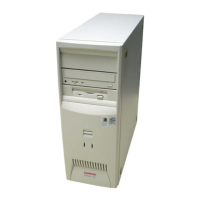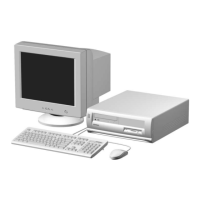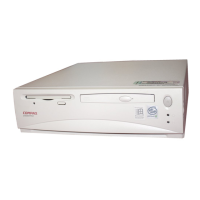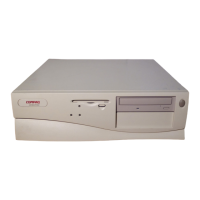Technical Reference Guide
Compaq Deskpro EP Series of Personal Computers
First Edition–- April 1998
4-29
4.6 REAL-TIME CLOCK AND CONFIGURATION MEMORY
The Real-time clock (RTC) and configuration memory functions are provided by the 82371 South
Bridge component. The RTC uses the first 14 of 256 bytes of configuration memory and is
MC146818-compatible. As shown in the following figure, the 82371 provides 256 bytes of
configuration memory (CMOS), divided into two 128-byte banks. The lower configuration
memory can be accessed using conventional OUT and IN assembly language instructions using
I/O ports 70h (index) and 71h (data). The upper configuration memory area is accessible using
ports 72h/73h. When using the OUT/IN instructions only addresses 00h-7Fh are valid.
Software should access CMOS using the INT15 AX=E823h BIOS call. This system supports the
Client Management BIOS function INT15 AX=E845h, which accesses CMOS feature bits data.
These functions are described in more detail in Chapter 7, “BIOS ROM.”
Figure 4–11.
Configuration Memory Map
A lithium 3-VDC battery is used for maintaining the RTC and configuration memory while the
system is powered down. During system operation a wire-Ored circuit allows the RTC and
configuration memory to draw power from the power supply.
The battery is located in a battery holder on the system board and has a life expectancy of from
four to eight years. When the battery has expired it is replaced with a Renata CR2032 or
equivalent 3-VDC lithium battery.
RTC Area
(14 bytes)
Lower Config.
Memory Area
(114 bytes)
Upper Config.
Memory Area
(128 bytes)
00h
0Dh
0Eh
00h (80h)
7Fh
FFh
7Fh
Seconds (Timer)
Minutes (Timer)
Seconds (Alarm)
Hours (Alarm)
Hours (Timer)
Minutes (Alarm)
Day of Week
Date of Month
Month
Year
Register A
Register B
Register C
Register D
00h
0Bh
01h
02h
03h
04h
05h
06h
07h
08h
09h
0Ah
0Dh
0Ch
82371

